Strategic Analysis of Coca-Cola's Mission, Values, and Strategy
VerifiedAdded on 2022/11/28
|6
|1271
|365
Report
AI Summary
This report provides a strategic analysis of The Coca-Cola Company, evaluating its mission statement, strategic decisions, and organizational culture. The report begins by assessing Coca-Cola's mission statement based on Andrew Campbell's framework, examining its purpose, stakeholder responsibility, business domain, and strategic positioning. It then delves into the company's strategic significances, including accelerating soft drink development, product expansion, system profitability, customer service, and market investment. Furthermore, the report explores Coca-Cola's status as a learning organization, highlighting its adaptability to innovative changes and global best practices. The analysis also covers the company's inclusive culture, emphasizing its values of leadership, passion, integrity, collaboration, diversity, quality, and accountability. Finally, the report outlines Coca-Cola's key strategic decisions, such as driving income and profit growth, investing in its brand, increasing worldwide efficiency, simplifying processes, and refocusing on its core business model. The report concludes with a bibliography of the sources used.
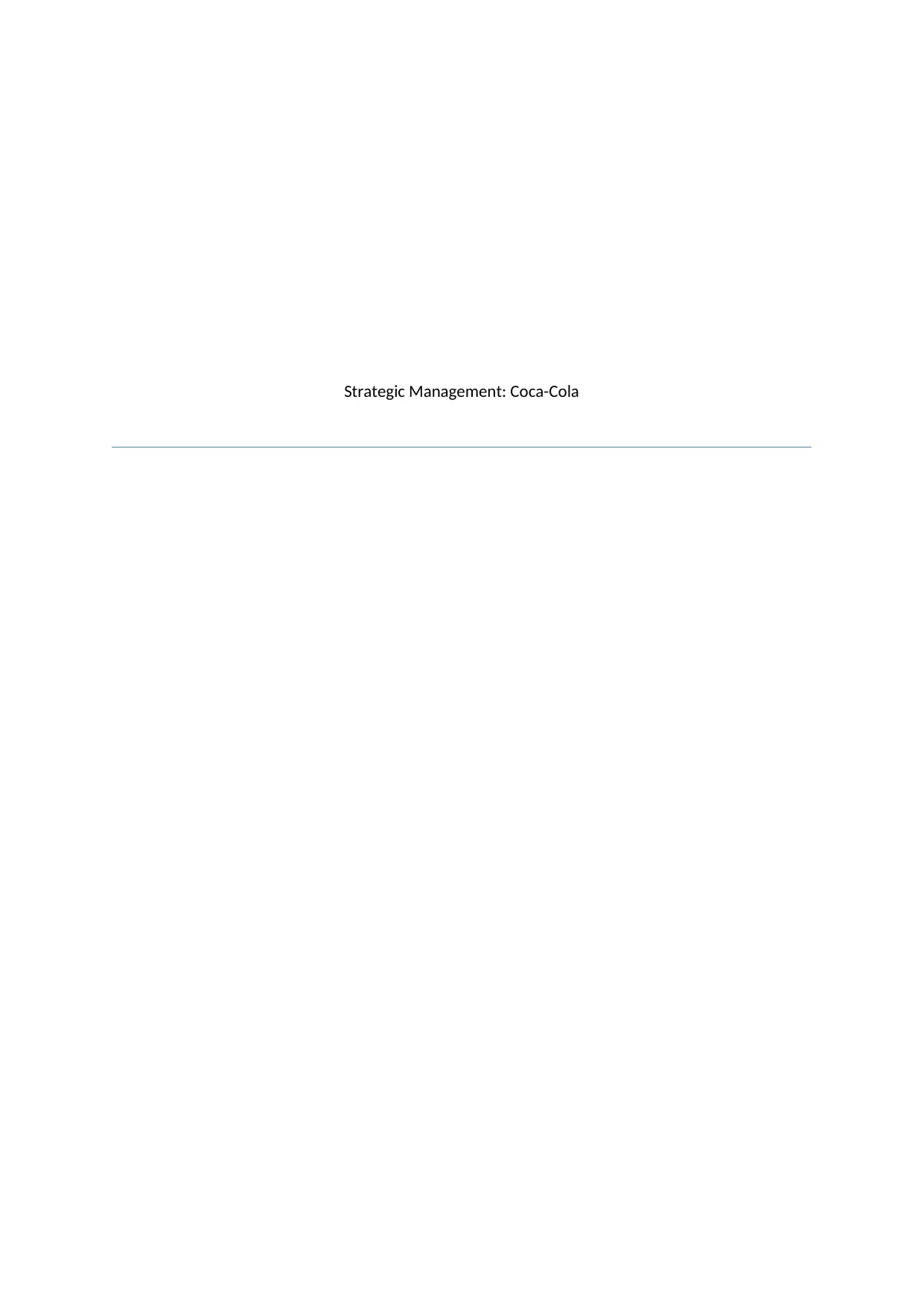
Strategic Management: Coca-Cola
Paraphrase This Document
Need a fresh take? Get an instant paraphrase of this document with our AI Paraphraser
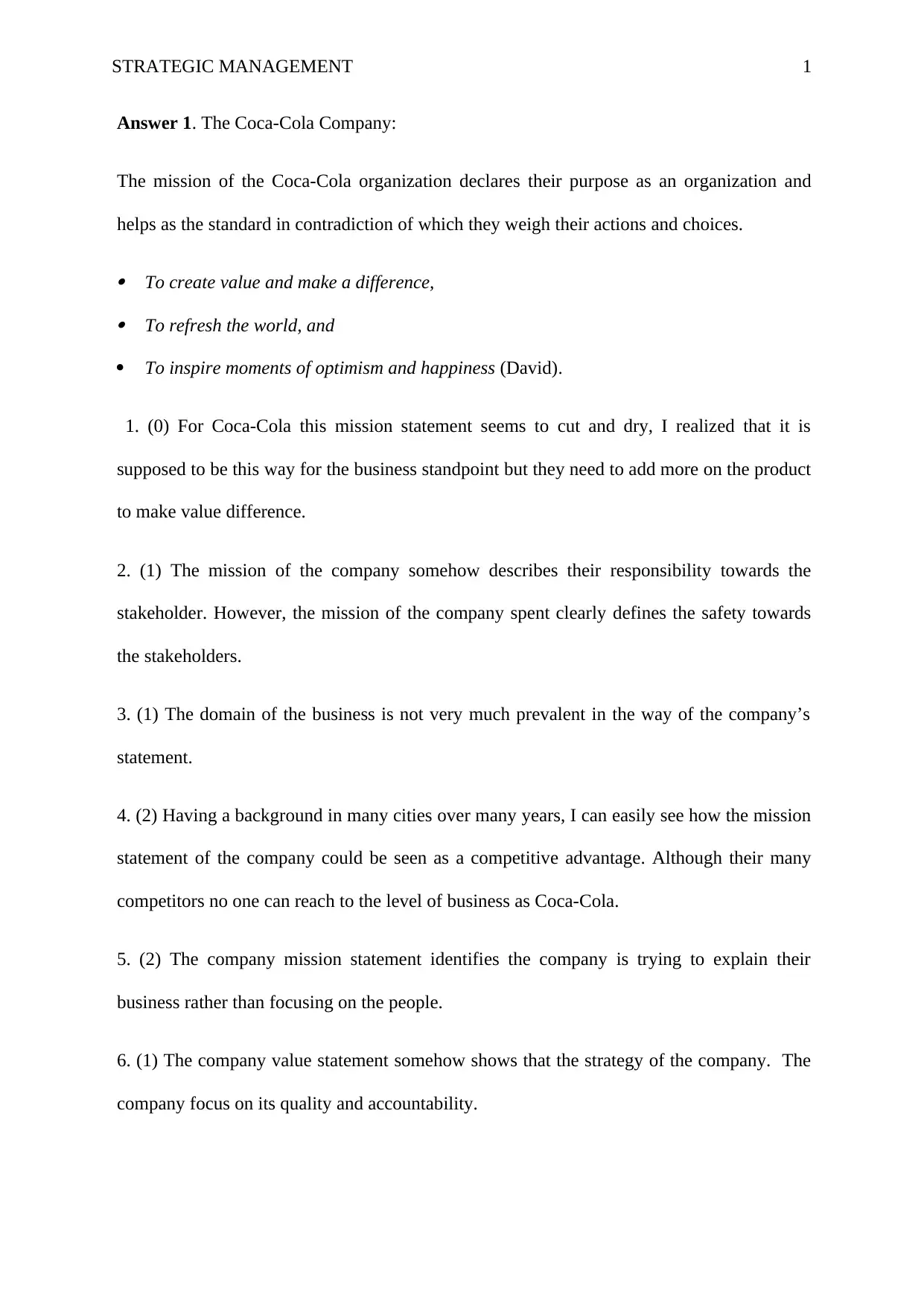
STRATEGIC MANAGEMENT 1
Answer 1. The Coca-Cola Company:
The mission of the Coca-Cola organization declares their purpose as an organization and
helps as the standard in contradiction of which they weigh their actions and choices.
To create value and make a difference,
To refresh the world, and
To inspire moments of optimism and happiness (David).
1. (0) For Coca-Cola this mission statement seems to cut and dry, I realized that it is
supposed to be this way for the business standpoint but they need to add more on the product
to make value difference.
2. (1) The mission of the company somehow describes their responsibility towards the
stakeholder. However, the mission of the company spent clearly defines the safety towards
the stakeholders.
3. (1) The domain of the business is not very much prevalent in the way of the company’s
statement.
4. (2) Having a background in many cities over many years, I can easily see how the mission
statement of the company could be seen as a competitive advantage. Although their many
competitors no one can reach to the level of business as Coca-Cola.
5. (2) The company mission statement identifies the company is trying to explain their
business rather than focusing on the people.
6. (1) The company value statement somehow shows that the strategy of the company. The
company focus on its quality and accountability.
Answer 1. The Coca-Cola Company:
The mission of the Coca-Cola organization declares their purpose as an organization and
helps as the standard in contradiction of which they weigh their actions and choices.
To create value and make a difference,
To refresh the world, and
To inspire moments of optimism and happiness (David).
1. (0) For Coca-Cola this mission statement seems to cut and dry, I realized that it is
supposed to be this way for the business standpoint but they need to add more on the product
to make value difference.
2. (1) The mission of the company somehow describes their responsibility towards the
stakeholder. However, the mission of the company spent clearly defines the safety towards
the stakeholders.
3. (1) The domain of the business is not very much prevalent in the way of the company’s
statement.
4. (2) Having a background in many cities over many years, I can easily see how the mission
statement of the company could be seen as a competitive advantage. Although their many
competitors no one can reach to the level of business as Coca-Cola.
5. (2) The company mission statement identifies the company is trying to explain their
business rather than focusing on the people.
6. (1) The company value statement somehow shows that the strategy of the company. The
company focus on its quality and accountability.

STRATEGIC MANAGEMENT 2
7. (2) The mission of the company outstanding describe behavior standards which serve as
beacons of the strategy and the values to the company. The company focuses on the culture
which is one of the most important behaviors.
8. (1) The behavior standards of the company do not help the individual employee to judge
the behavior of the company correctly.
9. (2) The mission of the company very nicely explains the culture of the organization. The
attitude which they have to adopt till 2020.
10. (2) The statement of the company is very easy to understand and also clear the working
criteria and goals of the company (Coca-Cola).
Answer 2. The achieve the goal of the organization. Company has recognized six strategic
significances illustrated as:
Accelerate carbonated soft drink development lead by the Coca-Cola.
Broaden the household of the product, where it is appropriate
Grow the system probability and capability altogether with the bottlers.
Serve the customers worldwide, and
Invest the money in the market.
These are the states which show the company strategic decisions.
Luckily, we can have items with zero sugar however despite everything we don't feel more,"
he included. "That is one reason we are currently moving our technique as we need to
continue quickening our duty (Walsh).
"So far our procedure has been the point at which we had a fixing we needed to restrain, to
dispatch a whole new brand with various qualities and another character. This procedure of
7. (2) The mission of the company outstanding describe behavior standards which serve as
beacons of the strategy and the values to the company. The company focuses on the culture
which is one of the most important behaviors.
8. (1) The behavior standards of the company do not help the individual employee to judge
the behavior of the company correctly.
9. (2) The mission of the company very nicely explains the culture of the organization. The
attitude which they have to adopt till 2020.
10. (2) The statement of the company is very easy to understand and also clear the working
criteria and goals of the company (Coca-Cola).
Answer 2. The achieve the goal of the organization. Company has recognized six strategic
significances illustrated as:
Accelerate carbonated soft drink development lead by the Coca-Cola.
Broaden the household of the product, where it is appropriate
Grow the system probability and capability altogether with the bottlers.
Serve the customers worldwide, and
Invest the money in the market.
These are the states which show the company strategic decisions.
Luckily, we can have items with zero sugar however despite everything we don't feel more,"
he included. "That is one reason we are currently moving our technique as we need to
continue quickening our duty (Walsh).
"So far our procedure has been the point at which we had a fixing we needed to restrain, to
dispatch a whole new brand with various qualities and another character. This procedure of
⊘ This is a preview!⊘
Do you want full access?
Subscribe today to unlock all pages.

Trusted by 1+ million students worldwide
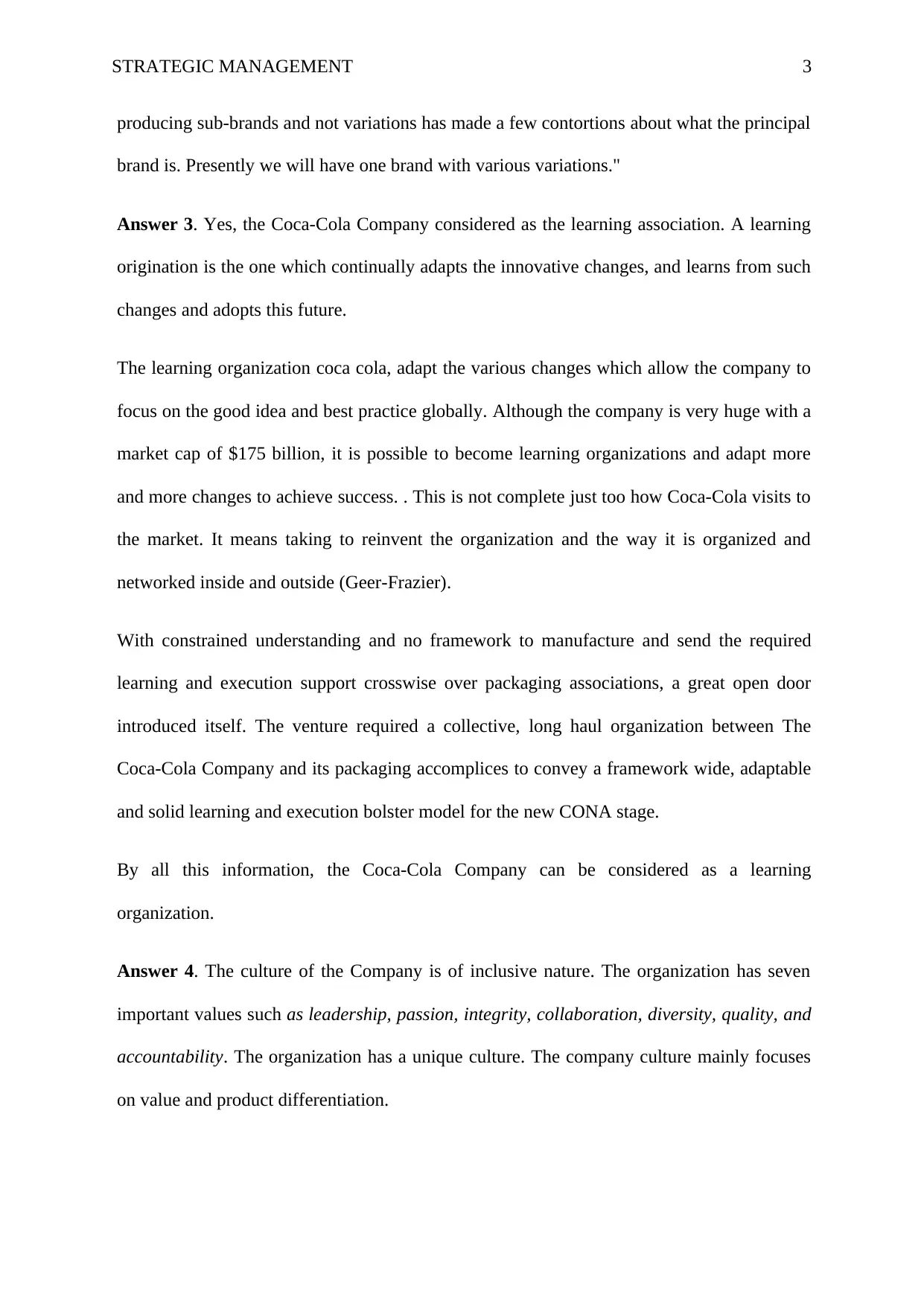
STRATEGIC MANAGEMENT 3
producing sub-brands and not variations has made a few contortions about what the principal
brand is. Presently we will have one brand with various variations."
Answer 3. Yes, the Coca-Cola Company considered as the learning association. A learning
origination is the one which continually adapts the innovative changes, and learns from such
changes and adopts this future.
The learning organization coca cola, adapt the various changes which allow the company to
focus on the good idea and best practice globally. Although the company is very huge with a
market cap of $175 billion, it is possible to become learning organizations and adapt more
and more changes to achieve success. . This is not complete just too how Coca-Cola visits to
the market. It means taking to reinvent the organization and the way it is organized and
networked inside and outside (Geer-Frazier).
With constrained understanding and no framework to manufacture and send the required
learning and execution support crosswise over packaging associations, a great open door
introduced itself. The venture required a collective, long haul organization between The
Coca-Cola Company and its packaging accomplices to convey a framework wide, adaptable
and solid learning and execution bolster model for the new CONA stage.
By all this information, the Coca-Cola Company can be considered as a learning
organization.
Answer 4. The culture of the Company is of inclusive nature. The organization has seven
important values such as leadership, passion, integrity, collaboration, diversity, quality, and
accountability. The organization has a unique culture. The company culture mainly focuses
on value and product differentiation.
producing sub-brands and not variations has made a few contortions about what the principal
brand is. Presently we will have one brand with various variations."
Answer 3. Yes, the Coca-Cola Company considered as the learning association. A learning
origination is the one which continually adapts the innovative changes, and learns from such
changes and adopts this future.
The learning organization coca cola, adapt the various changes which allow the company to
focus on the good idea and best practice globally. Although the company is very huge with a
market cap of $175 billion, it is possible to become learning organizations and adapt more
and more changes to achieve success. . This is not complete just too how Coca-Cola visits to
the market. It means taking to reinvent the organization and the way it is organized and
networked inside and outside (Geer-Frazier).
With constrained understanding and no framework to manufacture and send the required
learning and execution support crosswise over packaging associations, a great open door
introduced itself. The venture required a collective, long haul organization between The
Coca-Cola Company and its packaging accomplices to convey a framework wide, adaptable
and solid learning and execution bolster model for the new CONA stage.
By all this information, the Coca-Cola Company can be considered as a learning
organization.
Answer 4. The culture of the Company is of inclusive nature. The organization has seven
important values such as leadership, passion, integrity, collaboration, diversity, quality, and
accountability. The organization has a unique culture. The company culture mainly focuses
on value and product differentiation.
Paraphrase This Document
Need a fresh take? Get an instant paraphrase of this document with our AI Paraphraser
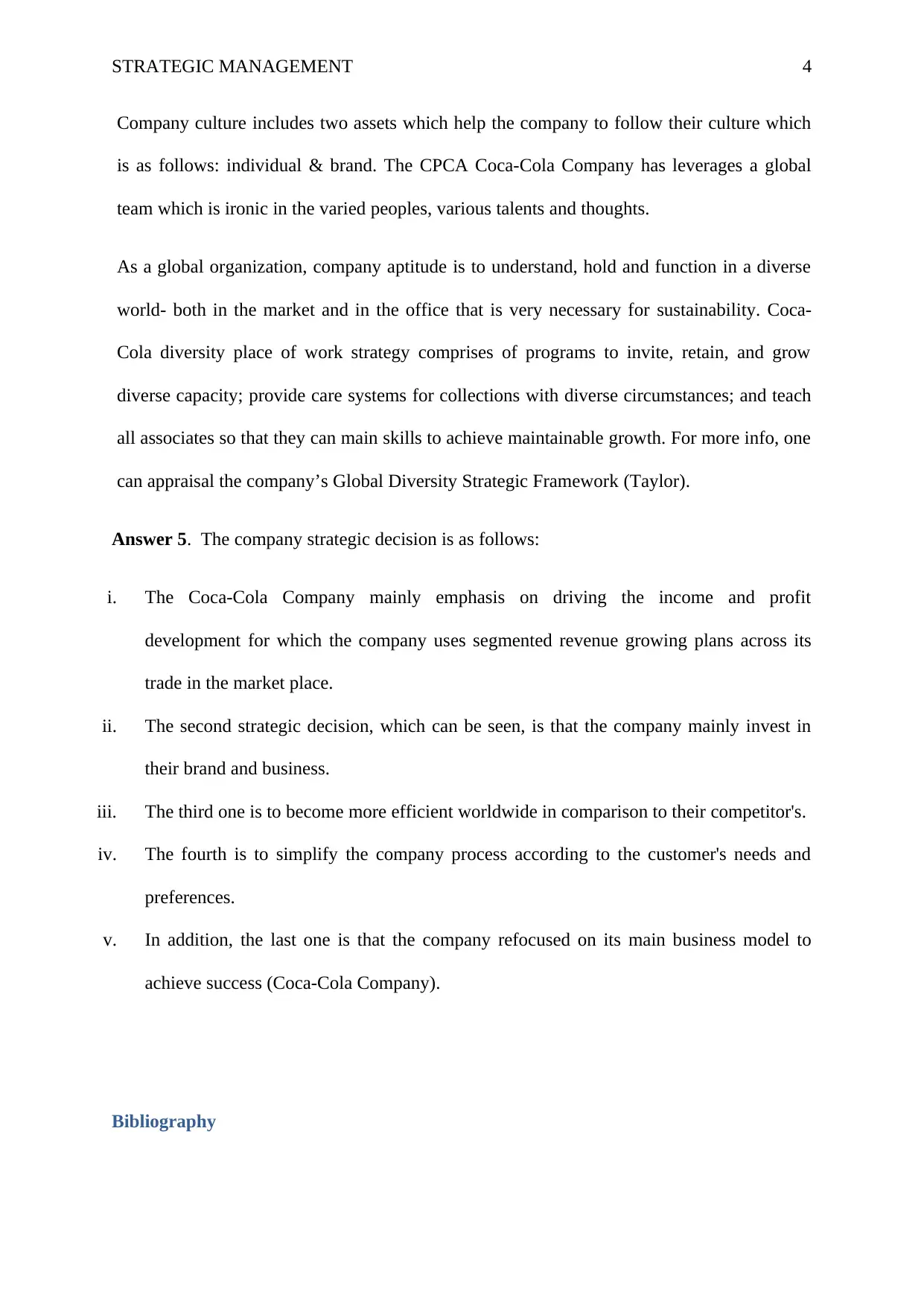
STRATEGIC MANAGEMENT 4
Company culture includes two assets which help the company to follow their culture which
is as follows: individual & brand. The CPCA Coca-Cola Company has leverages a global
team which is ironic in the varied peoples, various talents and thoughts.
As a global organization, company aptitude is to understand, hold and function in a diverse
world- both in the market and in the office that is very necessary for sustainability. Coca-
Cola diversity place of work strategy comprises of programs to invite, retain, and grow
diverse capacity; provide care systems for collections with diverse circumstances; and teach
all associates so that they can main skills to achieve maintainable growth. For more info, one
can appraisal the company’s Global Diversity Strategic Framework (Taylor).
Answer 5. The company strategic decision is as follows:
i. The Coca-Cola Company mainly emphasis on driving the income and profit
development for which the company uses segmented revenue growing plans across its
trade in the market place.
ii. The second strategic decision, which can be seen, is that the company mainly invest in
their brand and business.
iii. The third one is to become more efficient worldwide in comparison to their competitor's.
iv. The fourth is to simplify the company process according to the customer's needs and
preferences.
v. In addition, the last one is that the company refocused on its main business model to
achieve success (Coca-Cola Company).
Bibliography
Company culture includes two assets which help the company to follow their culture which
is as follows: individual & brand. The CPCA Coca-Cola Company has leverages a global
team which is ironic in the varied peoples, various talents and thoughts.
As a global organization, company aptitude is to understand, hold and function in a diverse
world- both in the market and in the office that is very necessary for sustainability. Coca-
Cola diversity place of work strategy comprises of programs to invite, retain, and grow
diverse capacity; provide care systems for collections with diverse circumstances; and teach
all associates so that they can main skills to achieve maintainable growth. For more info, one
can appraisal the company’s Global Diversity Strategic Framework (Taylor).
Answer 5. The company strategic decision is as follows:
i. The Coca-Cola Company mainly emphasis on driving the income and profit
development for which the company uses segmented revenue growing plans across its
trade in the market place.
ii. The second strategic decision, which can be seen, is that the company mainly invest in
their brand and business.
iii. The third one is to become more efficient worldwide in comparison to their competitor's.
iv. The fourth is to simplify the company process according to the customer's needs and
preferences.
v. In addition, the last one is that the company refocused on its main business model to
achieve success (Coca-Cola Company).
Bibliography
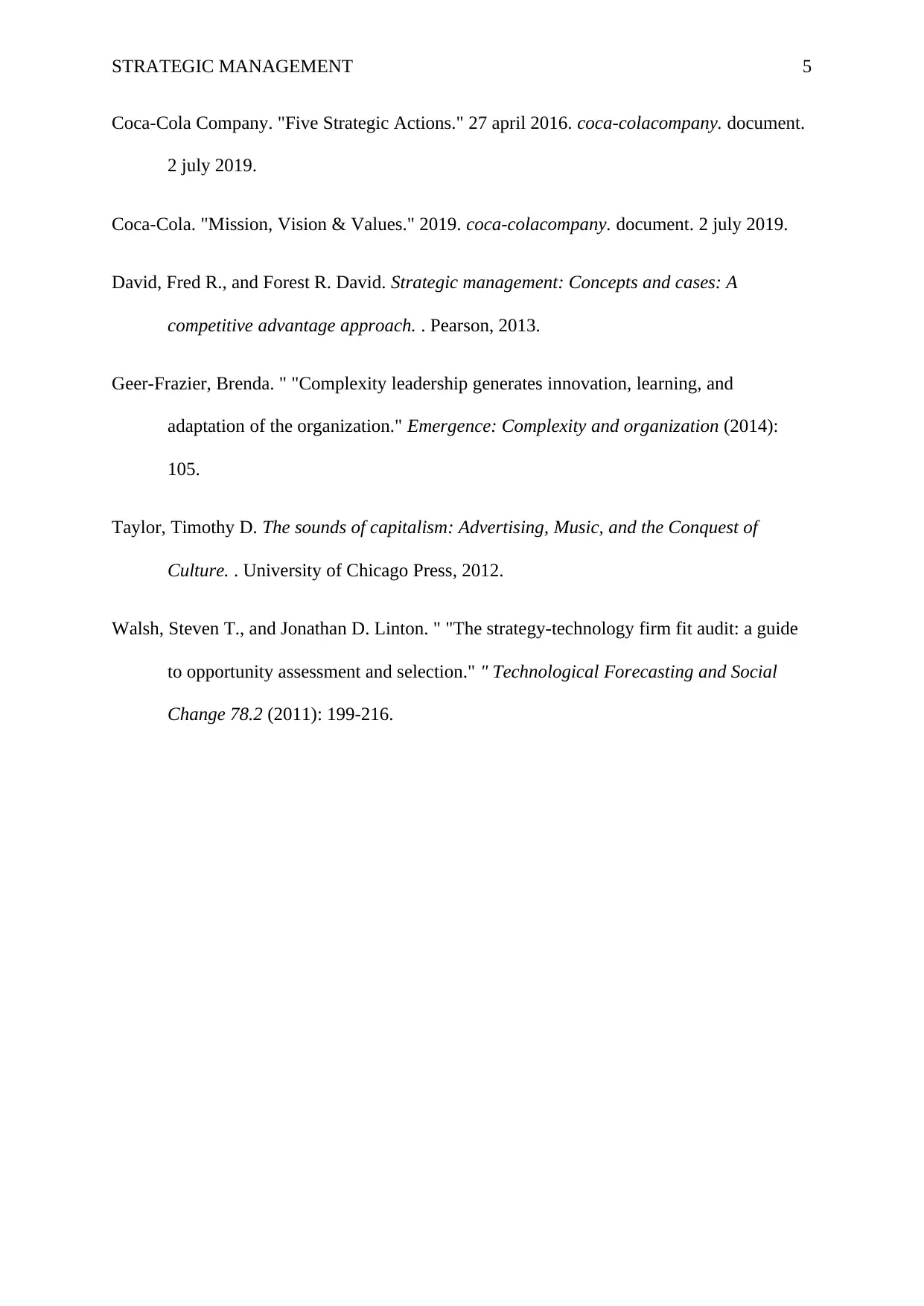
STRATEGIC MANAGEMENT 5
Coca-Cola Company. "Five Strategic Actions." 27 april 2016. coca-colacompany. document.
2 july 2019.
Coca-Cola. "Mission, Vision & Values." 2019. coca-colacompany. document. 2 july 2019.
David, Fred R., and Forest R. David. Strategic management: Concepts and cases: A
competitive advantage approach. . Pearson, 2013.
Geer-Frazier, Brenda. " "Complexity leadership generates innovation, learning, and
adaptation of the organization." Emergence: Complexity and organization (2014):
105.
Taylor, Timothy D. The sounds of capitalism: Advertising, Music, and the Conquest of
Culture. . University of Chicago Press, 2012.
Walsh, Steven T., and Jonathan D. Linton. " "The strategy-technology firm fit audit: a guide
to opportunity assessment and selection." " Technological Forecasting and Social
Change 78.2 (2011): 199-216.
Coca-Cola Company. "Five Strategic Actions." 27 april 2016. coca-colacompany. document.
2 july 2019.
Coca-Cola. "Mission, Vision & Values." 2019. coca-colacompany. document. 2 july 2019.
David, Fred R., and Forest R. David. Strategic management: Concepts and cases: A
competitive advantage approach. . Pearson, 2013.
Geer-Frazier, Brenda. " "Complexity leadership generates innovation, learning, and
adaptation of the organization." Emergence: Complexity and organization (2014):
105.
Taylor, Timothy D. The sounds of capitalism: Advertising, Music, and the Conquest of
Culture. . University of Chicago Press, 2012.
Walsh, Steven T., and Jonathan D. Linton. " "The strategy-technology firm fit audit: a guide
to opportunity assessment and selection." " Technological Forecasting and Social
Change 78.2 (2011): 199-216.
⊘ This is a preview!⊘
Do you want full access?
Subscribe today to unlock all pages.

Trusted by 1+ million students worldwide
1 out of 6
Related Documents
Your All-in-One AI-Powered Toolkit for Academic Success.
+13062052269
info@desklib.com
Available 24*7 on WhatsApp / Email
![[object Object]](/_next/static/media/star-bottom.7253800d.svg)
Unlock your academic potential
Copyright © 2020–2025 A2Z Services. All Rights Reserved. Developed and managed by ZUCOL.





